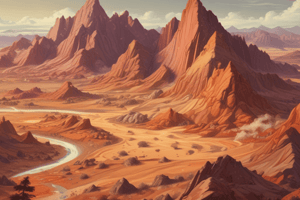Podcast
Questions and Answers
What are the physical elements of landforms that comprise a landscape?
What are the physical elements of landforms that comprise a landscape?
- Mountains and hills
- Only human elements including buildings and structures
- Mountains, hills, and living elements of landcover (correct)
- Rivers and oceans
What is the primary distinction between internal and external forces that shape the Earth's surface?
What is the primary distinction between internal and external forces that shape the Earth's surface?
- Internal forces are geological, while external forces are biological.
- Internal forces are responsible for erosion, while external forces are responsible for deposition.
- Internal forces originate from within the Earth, while external forces originate from outside. (correct)
- Internal forces are slow-acting, while external forces are fast-acting.
What type of landscape is characterized by streams and river channels that are dry for most of the year?
What type of landscape is characterized by streams and river channels that are dry for most of the year?
- Arid landscapes (correct)
- Humid landscapes
- Coastal landscapes
- Glacial landscapes
What type of landscapes are characterized by the presence of glaciers?
What type of landscapes are characterized by the presence of glaciers?
What is the definition of a landform?
What is the definition of a landform?
What is an example of a biological factor that can influence landforms?
What is an example of a biological factor that can influence landforms?
What is the main geomorphic agent in coastal landscapes?
What is the main geomorphic agent in coastal landscapes?
Who is credited with the observation that rocks over Lower Egypt contained marine fossils, suggesting sea level changes?
Who is credited with the observation that rocks over Lower Egypt contained marine fossils, suggesting sea level changes?
What is the primary process responsible for creating and affecting landforms?
What is the primary process responsible for creating and affecting landforms?
What is the term for the study of the Earth's physical features?
What is the term for the study of the Earth's physical features?
What is the term for the visual and physical characteristics of an area?
What is the term for the visual and physical characteristics of an area?
Which ancient Greek philosopher described erosion by rivers and deposition in deltas?
Which ancient Greek philosopher described erosion by rivers and deposition in deltas?
What is the term for the study of the shape and character of the land surface?
What is the term for the study of the shape and character of the land surface?
Who is associated with the concept of the geographical cycle of erosion in humid and arid areas?
Who is associated with the concept of the geographical cycle of erosion in humid and arid areas?
Flashcards are hidden until you start studying
Study Notes
Forces Shaping the Earth's Surface
- Internal forces: tectonic movements, volcanic activities, earthquakes
- External forces: denudational processes (weathering, mass wasting, glacial, fluvial, wind actions)
Landform and Landscape
- Landform: the shape and character of the land surface resulting from the interaction of physical and human processes
- Landform: a specific geomorphic feature on the Earth, ranging from large scale features (plains and mountain ranges) to minor features (individual gullies, faults, and valleys)
- Landscape: comprises the visible features of an area of land, including physical elements of landforms, living elements of land cover, and human elements
- Landscape: an overlay of physical and cultural elements on Earth
Landscape Types/Classification
- Arid landscapes: environments where streams and river channels are dry for most of the year
- Arid landscapes have two types of landforms:
- those where wind is the main agent of erosion/evolution
- those where water is the main agent of erosion/evolution
- Coastal landscapes: environments where water is the main geomorphic agent
- Coastal landscapes have landforms created by both water and wind
- Humid landscapes, volcanic landscapes, and glacial landscapes are also classified landscape types
Historical Development of Geomorphology
- Ancient Period: includes works of Herodotus, Aristotle, Ptolemy, and Strabo
- Dark Ages: includes the concept of the Noachian Deluge and Avicenna
- Renaissance: includes the works of Leonardo da Vinci, Buffon, Gutterhard, James Hutton, John Playfair, and Charles Lyell
- Modern Period: includes the geographical cycle of erosion, qualitative and quantitative geomorphology, and concepts from W.M.Davis, Walther Penck, Crickmay, Johnson, and Agassiz
Historical Figures
- Herodotus (485?-425 B.C.): suggested sea level changes and the formation of the Nile Delta over thousands of years
- Aristotle (384-322 B.C.): described erosion by rivers and deposition in deltas, and proposed that land can be raised from beneath the ocean
Studying That Suits You
Use AI to generate personalized quizzes and flashcards to suit your learning preferences.




